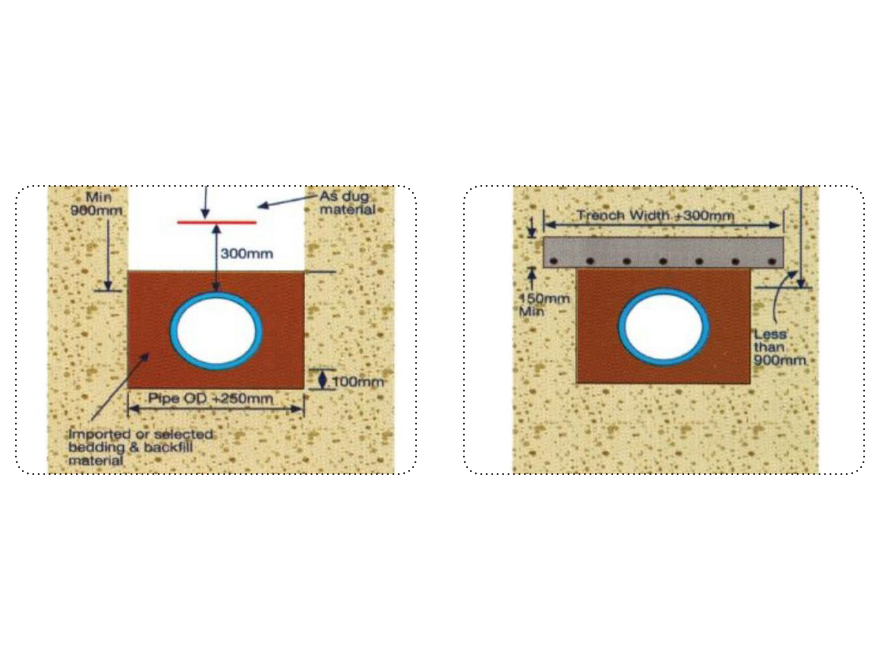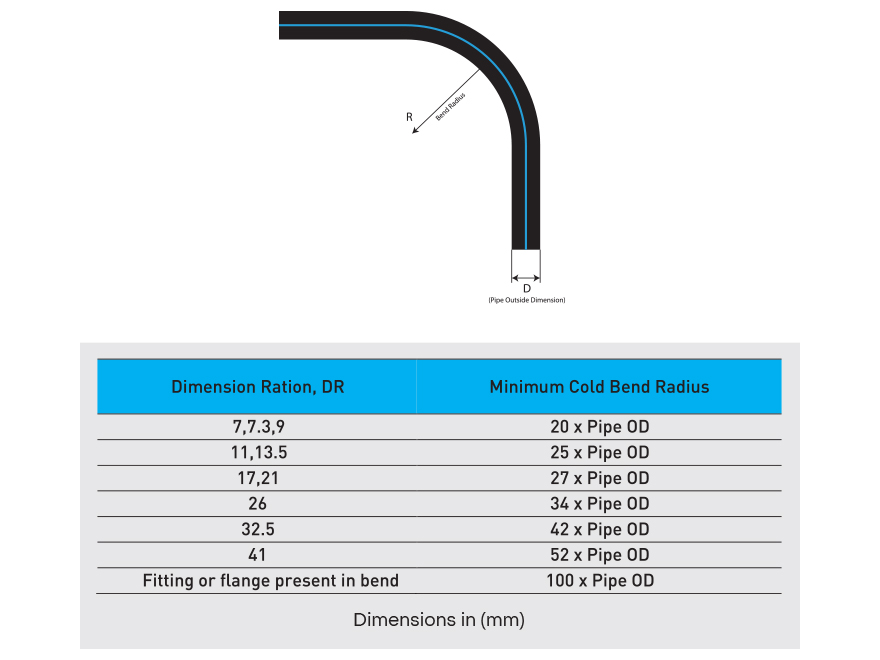Application of Polyethylene Pipes
Therefore, the range of applications for polyethylene pipes today are considerable:
1 . Water supply systems.
2 . Sewage and Drainage water systems.
3 . Mining.
4 . Agriculture, irrigation and drip irrigation system.
5 . Power and communication conduits.
6 . Chemical process pipelines.
7 . Temporary or bypass pipelines.
8 . Firefighting lines.
9 . Rehabilitation for old utility lines.
10 . Fuel stations main lines.
11 . Oil and gas applications
Installation HDPE Pipes
constructed to prove a firm, stable and uniform support from the full length of the pipe- When an unstable sub-grade condition is encountered which will provide inadequate pipe support, additional trench depth should be excavated and refilled with suitable foundation materials as specified by the engineer
- The ground water level in the trench should be kept below the pipe
Bedding:

- Bedding is required primarily to bring the trench bottom up to grade.
- Bedding materials should be placed to provide a uniform and adequate longitudinal support
under the pipe.
- A compacted depth of 4 to 6 inches (100-150mm) is generally sufficient bedding thickness.
- Bedding material should be free of ridges, hollows and lumps.
- The trench bottom should be smooth and free of rocks.
- Bedding should consist of free flowing material such as gravel, sand, salty sand or clayey sand
that is free of stones or hard practices larger than 1 1\2 inch.
Haunching:

The most important factor affecting the pipe performance and deflection is the haunching material
and its density
- Material should be placed and consolidated under the pipe haunch to provide adequate side
support to the pipe while avoiding both vertical and lateral displacement of the pipe from proper
alignment.
- Where coarse material with voids has been used for bedding, the same coarse material should
also be used for haunching and consideration should be given to native soil migration.
- Haunching is placed up to the pipe spring line.
Initial Backfill:
Initial backfill is that portion of the pipe embedment beginning at the spring line of extending
some distance over the pipe and the top of the pipe.
- Since no additional side support is gained above the spring line, native soil may be used without
special compaction efforts.
- The sole purpose of somewhat careful placement of these native trench materials is to protect
the pipe from the dropping of large rocks or other impact loads that may occur during final backfill.
- Minimum cover is recommended to be 6 inch (150mm)
Final Backfill:
The material used in the final backfilling operation need not to be as carefully selected as the bedding, haunching and the initial backfill material, exclude boulders, frozen clumps of dirt, and rubble which could damage the pipe.
Engineered Trench Specification:

For applications where the simplified installation guidelines do not apply -- such as gravity flow pipes that are relatively deep, shallow cover applications where the pipe is subject to vehicular or train loading, pipes placed in unstable, soft, or wet soils, high DR pipes, or pipes in deep applications such as landfills and embankments -- the engineer must prepare a specific embedment specification. In these cases, detailed attention must be paid to the native soil, the embedment soil, and the placement of the embedment soil. The key objective of installation is to minimize or control subsequent pipe deflection. A limit of 5% is commonly used, which provides an additional safety factor, as most gravity flow PE pipe can withstand higher deflection without damage. The load carrying capability of a PE pipe, particularly a pipe with a high DR, can be greatly increased by the soil in which it is embedded, including the installation procedure. When the pipe is loaded, load is transferred from the pipe to the soil by a horizontal outward movement of the pipe wall. This enhances contact between pipe and soil and mobilizes the passive resistance of the soil. This resistance aids in preventing further pipe deformation and contributes to the support for the vertical loads. The factors to be considered in a properly engineered installation specification include pipe embedment materials, compaction of embedment materials, trench dimensions, and trench design and construction. These four items are discussed separately

For applications where the simplified installation guidelines do not apply -- such as gravity flow pipes that are relatively deep, shallow cover applications where the pipe is subject to vehicular or train loading, pipes placed in unstable, soft, or wet soils, high DR pipes, or pipes in deep applications such as landfills and embankments -- the engineer must prepare a specific embedment specification. In these cases, detailed attention must be paid to the native soil, the embedment soil, and the placement of the embedment soil. The key objective of installation is to minimize or control subsequent pipe deflection. A limit of 5% is commonly used, which provides an additional safety factor, as most gravity flow PE pipe can withstand higher deflection without damage. The load carrying capability of a PE pipe, particularly a pipe with a high DR, can be greatly increased by the soil in which it is embedded, including the installation procedure. When the pipe is loaded, load is transferred from the pipe to the soil by a horizontal outward movement of the pipe wall. This enhances contact between pipe and soil and mobilizes the passive resistance of the soil. This resistance aids in preventing further pipe deformation and contributes to the support for the vertical loads. The factors to be considered in a properly engineered installation specification include pipe embedment materials, compaction of embedment materials, trench dimensions, and trench design and construction. These four items are discussed separately
Benging:

One of the important features of using HDPE pipes is its flexibility. However it is important that the bending radius at any point should not be less than 20 times the pipe outside diameter when at an ambient temperature of 20 °C. When lower temperatures are encountered it is necessary to progressively increase the minimum bending radius by a factor of up to 2.5 times at 0 °C.

Minimum Bend Radius for PE Pipe Installed in Open Cut Trench
